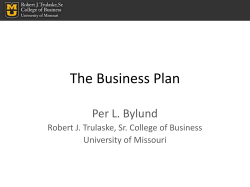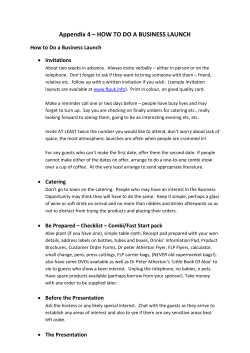
Launch Your Own Content Marketing Program
LAUNCH YOUR OWN CONTENT MARKETING PROGRAM WHY. WHO. HOW WHY LAUNCH A CONTENT MARKETING PROGRAM? Content marketing, and the creation of content-driven experiences, has proven to be an extraordinarily powerful new way for marketers to create value for business. The idea of a brand approaching customer engagement by providing education, delight, and general usefulness offers a new model for enriching our interactions with customers at every stage of the buying journey. The problem is that while consumers have evolved and embraced experiencebased marketing, marketers themselves haven’t necessarily established their vision, processes, and procedures for building those experiences. In all but the most forward-thinking organizations, content is everyone’s job and no one’s at the same time. It’s primarily treated as a project that the business experiments with, rather than a process that should be integrated into every function of the organization as a whole. LAUNCH YOUR OWN CONTENT MARKETING PROGRAM CONTENT-DRIVEN MARKETING IS THE DIFFERENTIATING FUNCTION OF BUSINESS It’s time for content marketers to lean in, step up, and lead businesses into the future. We must move beyond being an on-demand group built to support sales, and start to function as a strategic partner that can help the business predict and adapt to new disruptions. For many businesses, though, there are knowledge barriers that keep them from realizing their content marketing mission. They need help organizing the essential information, using it to craft a unique and valuable purpose, and building the processes and procedures that are necessary to support ongoing content marketing success. LAUNCH YOUR OWN CONTENT MARKETING PROGRAM DON’T GET LOST IN SPACE That’s why we created this workbook: to help your organization transform its marketing operations — from a subservient department that merely describes the value of a product or service into an enterprise-wide function that can capitalize on the benefits of content-based engagement. In the pages that follow, we will guide you through a series of easy-to-complete practical exercises that will help you view content marketing as a logical extension of your brand’s core values and set the infrastructure necessary to implement a distinctive, engaging, and scalable content marketing program. There’s a world of content marketing opportunities out there, just waiting to be explored. Follow our path to the launchpad, and prepare for takeoff! LAUNCH YOUR OWN CONTENT MARKETING PROGRAM PHASE ONE A PURPOSE-DRIVEN CONTENT MISSION Discover the answers to these key questions: What business goals do we want our content to help us achieve? How do we get the team support we need to strategically create content? How do we come up with content ideas that speak to our goals? CONTENT MARKETING ISN’T A ONE-TIME CAMPAIGN It’s a continuously evolving process that follows a strategic path, based on your organization’s goals, assets, and unique value propositions. No two content marketing strategies are alike, so each one needs to start with a little self-exploration… LAUNCH YOUR OWN CONTENT MARKETING PROGRAM STEP 1. IDENTIFY YOUR BUSINESS OBJECTIVES (STARTING FROM SCRATCH) If you are just starting out with content marketing, you need to find the purpose that will drive your strategy. One easy trick for doing this is to look at your business funnel and identify the point where your team is struggling the most to reach its goals. For example: Are you a start-up that needs to gain awareness in the marketplace? Are you having difficulties distinguishing your business from your competition? Do you get lots of leads, but have trouble “closing the deal”? Our greatest challenge is: LAUNCH YOUR OWN CONTENT MARKETING PROGRAM STEP 1. IDENTIFY YOUR BUSINESS OBJECTIVES (OPTIMIZING YOUR PROGRAM) If you have already begun to create content but are struggling to get the results you were expecting, you might want to start with an honest assessment of your content efforts: Are we doing true content marketing, or are we simply trying to make content fit into our traditional marketing processes? Is any of the content we already have worth scaling? Do we have a sustainable process – or simply a bunch of unrelated projects? Do we have the support we need to be successful? LAUNCH YOUR OWN CONTENT MARKETING PROGRAM STEP 2. COMPOSE YOUR CONTENT MARKETING MISSION Once you have identified the challenges you need to CONTENT MARKETING MISSION STORY FIRST “What’s the valuable experience?” address (i.e., your content’s purpose), use this information to inform your Content Marketing Mission Statement — an outline of your company’s reason for creating content and the priorities and perspectives it will uphold in pursuit of that mission. HOW WILL IT EXPRESS ITSELF? “What’s the valuable experience?” HOW WILL WE SUSTAIN IT? “Responsible management” WHAT IS SUCCESS? “What business goals?” HOW DO WE ENABLE IT? “Let’s build value” LAUNCH YOUR OWN CONTENT MARKETING PROGRAM STEP 2. COMPOSE YOUR CONTENT MARKETING MISSION Your content Marketing Mission should govern every piece of content you create from now on. As such, it should speak to some key components of any successful marketing endeavor: The core audience target: The type of person you can help most with your content What will be delivered to the audience: The types of information you will provide through your content The desired outcome for the audience: Things your audience will be able to do once they have consumed your content To home in on the components that should make up your unique mission, write your answers to the following questions in the space provided on the next page: 1. What is our goal? 2. What target audience can help us satisfy that goal? 3. What valuable experience — separate from our product or service — can we deliver at a key stage of their journey? 4. What makes OUR approach to delivering this value different? What is the DIFFERENT story that we’re telling? LAUNCH YOUR OWN CONTENT MARKETING PROGRAM YOUR TURN: CREATE YOUR CONTENT MARKETING MISSION STATEMENT 1 What is our goal? 2 What target audience can help us satisfy that goal? 3 What valuable experience can we deliver at a key stage of their journey? 4 What makes OUR approach to delivering this value different? Our mission: LAUNCH YOUR OWN CONTENT MARKETING PROGRAM STEP 3. GENERATE SOME STARTER IDEAS THAT FULFILL YOUR MISSION With your mission statement in hand, you now can start to come up with a few general ideas for addressing the key business goals your organization is looking to achieve with content marketing, such as: Increased sales leads Greater awareness in the marketplace Increased customer loyalty More favorable industry reputation Greater marketing efficiency In the exercise on the next page, choose a business goal to focus on, and write down your ideas. At this point, you have no real creative restraints — feel free to get imaginative and explore out-ofthe-box topics and ideas, even if they don’t seem executable right now. Later, we’ll help you narrow the field to the only the most feasible ideas that have the greatest potential to impact your bottom line. LAUNCH YOUR OWN CONTENT MARKETING PROGRAM YOUR TURN: USE GOALS TO COME UP WITH CONTENT IDEAS Step 1: Pick a business goal to focus on. It should be: Step 2: Write down two content ideas that you think would meet this goal: 1. An existing goal you believe content marketing will make incrementally better, or... 1. An idea to change to something you’re already doing with content marketing or would like to start doing, and… 2. A stretch goal that an innovative content marketing program could potentially help you achieve. Format: X Goal in Y Time with Z Constraint Example: “Deliver 25% more leads in 9 months w/ same CPL or less” 2. An out-of-the-box idea would you try if you could. Examples: “Create content to entertain people and make them laugh about what might be considered ‘serious’ heavy machinery.” “Create a thought leadership program that will send more qualified leads into the sales process.” LAUNCH YOUR OWN CONTENT MARKETING PROGRAM YOUR TURN: USE GOALS TO COME UP WITH POTENTIAL CONTENT IDEAS GOAL: IDEAS: 1 2 Hold onto these ideas for now. We’ll revisit them shortly… LAUNCH YOUR OWN CONTENT MARKETING PROGRAM PHASE TWO FIND YOUR TARGET AUDIENCE Discover the answers to these key questions: Who is our content meant to reach? How can we provide value to them, beyond our products and services? How can we use our content to support them through their buyer’s journey? BUILD PERSONAS FOR YOUR TARGET AUDIENCES Ideally, your content marketing should be crafted to benefit one audience at a time. To do this, you will need to identify your primary personas and ask some key questions to uncover the Unique Value Proposition (UVP) you can provide through your content. Start by describing the ideal customer who might benefit most from the content you create: WHO is the persona? What traits characterize her? WHAT roles does she play? What does her typical day look like? WHERE is there a gap in her needs/wants (beyond our products/services)? WHEN does she need to close this gap (i.e., where is she in the purchase funnel)? WHY would she care about us, as a company (aside from our product)? LAUNCH YOUR OWN CONTENT MARKETING PROGRAM YOUR TURN: BUILD A TARGET PERSONA TARGET PERSONA: ______________________________________ Job title/Role: _____________________________________________________ Typical challenge: _________________________________________________ Place your persona’s picture here and give her a name, to help Needs Gap: ________________________________________________________ your content team keep her top-of-mind. Funnel position: __________________________________________________ What she cares about: ____________________________________________ LAUNCH YOUR OWN CONTENT MARKETING PROGRAM NEXT: REVISIT YOUR INITIAL IDEAS AND ALIGN THEM WITH YOUR PERSONAS Earlier, you created two content ideas that would help meet your organization’s business goals. Now, it’s time to see if either (or both) will meet your persona’s needs as well. For example, while both of the ideas below would benefit a machinery business, only the first one would offer any benefit to its audience: 1. “Create content to entertain people and make them laugh about what might be considered ‘serious’ heavy machinery.” 2.“Create a thought leadership program that will send more qualified leads into the sales process.” If you find you have ideas that don’t fit the bill, you can make adjustments, or come up with an alternative idea. Fill in your revised ideas in the space on the next page. LAUNCH YOUR OWN CONTENT MARKETING PROGRAM YOUR TURN: USE GOALS TO COME UP WITH CONTENT IDEAS ORIGINAL IDEAS: AUDIENCE-ADJUSTED IDEAS: 1 2 Keep these ideas in a safe place — they’ll come in handy for our next exercise… LAUNCH YOUR OWN CONTENT MARKETING PROGRAM PHASE THREE STARTING WITH WHY: GETTING TO THE HEART OF OUR STORY Discover the answers to these key questions: How do we find the story we were meant to tell through our content? How do we ensure we’ve focused our content on meeting our audience’s needs, as well as our own? How do we translate our story into enough content to support our mission? FIND YOUR UNIQUE STORY Now that you understand who your target audience members are, as people, and have some content ideas that will provide value, you can start thinking about how to take it to the next step and forge an emotional connection with them. One way to approach this is to create a story around the desirable qualities and unique value proposition that only your business can provide. LAUNCH YOUR OWN CONTENT MARKETING PROGRAM DIFFERENTIATE TELL A DIFFERENT STORY NOT THE SAME ONE IN AN INCREMENTALLY BETTER WAY THE 5 WHYS… This exercise can help you take a generic content idea and turn it into a story that addresses the audience’s interests in relation to your company’s unique value proposition. Start with a topic you have used in your content — or one you have seen your competition use in their content. Next, ask yourself why that particular topic is important to your target audience. Then, write down your answer. Then, take that answer and ask why THIS matters to your audience. Do this until you have five questions and five answers. LAUNCH YOUR OWN CONTENT MARKETING PROGRAM For example: Let’s say your company provides modular data centers, and your target audience is CIOs. The process would look like this: Q: Why is this topic important to CIOs? A: Because our modularized data centers are less expensive and more agile than traditional data centers. Q: Why is it important for CIOs to have less expensive and more agile data centers? A: Because the needs of computing in the business are rising exponentially, and CIOs need to have faster/less expensive ways to manage their costs. Q: Why is it important for CIOs to know about ways to manage costs and be faster? A: Because if they stay current with these future trends, then they can expand their business more quickly and have a competitive advantage. LAUNCH YOUR OWN CONTENT MARKETING PROGRAM Q: Why is it important for CIOs to learn about how future trends can give their business a competitive advantage? A: Because if they don’t stay ahead of the curve, their company may go out of business, or they may be out of a job. Q: Why is that important to CIOs? A: Because their livelihood depends on having this knowledge. LAUNCH YOUR OWN CONTENT MARKETING PROGRAM PUT THEM TOGETHER TO CREATE A STORY ANGLE WITH REAL EMOTIONAL IMPACT: Using the information gathered through this process, our data center marketer could build a deeper story, like this: We believe in the office of the CIO… But things are changing fast – and in order for them to stay competitive on the job market, they must stay ahead of the curve or they (or their company) will be out of business. So, we help them stay current by delivering the most important future trends to help them expand their business and create competitive advantage. The needs of business computing are rising exponentially, and CIOs must keep up with ways to do things faster, and less expensively. Modularized, containerized data centers — and the trends and best practices in deploying them — are a powerful new way for the CIO to stay competitive. LAUNCH YOUR OWN CONTENT MARKETING PROGRAM YOUR TURN: ASK YOUR OWN 5 WHYS For this exercise, you can use your audience-adjusted ideas from Phase Two, or come up with some new ones. GOAL: IDEA: TARGET PERSONA: WHY #1: LAUNCH YOUR OWN CONTENT MARKETING PROGRAM YOUR TURN: ASK YOUR OWN 5 WHYS ANSWER #1: WHY #2: LAUNCH YOUR OWN CONTENT MARKETING PROGRAM YOUR TURN: ASK YOUR OWN 5 WHYS ANSWER #2: WHY #3: LAUNCH YOUR OWN CONTENT MARKETING PROGRAM YOUR TURN: ASK YOUR OWN 5 WHYS ANSWER #3: WHY #4: LAUNCH YOUR OWN CONTENT MARKETING PROGRAM YOUR TURN: ASK YOUR OWN 5 WHYS ANSWER #4: WHY #5: LAUNCH YOUR OWN CONTENT MARKETING PROGRAM YOUR TURN: APPLY YOUR 5 WHYS ANSWER #5: THE MAGIC STATEMENT: WHY #5: Now, use your 5 Whys to uncover your deeper story: YOUR DEEPER STORY: LAUNCH YOUR OWN CONTENT MARKETING PROGRAM PHASE FOUR THE PROCESS OF CONTENT CREATION MANAGEMENT (CCM) FROM CALENDARS TO CALIBRATION Discover the answers to these key questions: What team resources will we need to produce high quality content on a consistent basis? What core materials and processes should we implement for content creation and management With your strategic direction set, it’s time to establish a strong foundation that will support all your content creation and distribution efforts. Though there are many decisions that can factor into large-scale content marketing operations, you can start by thinking about the essentials below, and then revisit and refine your decisions as additional needs and opportunities take shape. The Team: Determine who will be involved in content creation, and what specific tasks each team member will be responsible for. The Workflow: Establish what tasks need to be completed to bring a content idea to fruition, what order those tasks will be completed in, how you will keep the process organized, and who will be in charge of making sure each content asset makes it to the next step in the process. The Tactical Plan: What topics will you cover? How often will you publish, and on which channels? What editorial guidelines and quality standards will you set? How will you track and measure your progress? These decisions should all factor into your tactical plan. LAUNCH YOUR OWN CONTENT MARKETING PROGRAM ASSIGN YOUR ROLES, WHICH TRANSLATE TO CONTENT MARKETING RESPONSIBILITIES 1. Chief Content Officer: The strategic lead is responsible for setting the overall editorial/content marketing mission statement and integrating that throughout the enterprise. 2. The Managing Editor is in charge of execution, working with the team to make the stories come alive (including tone, style guides, and content scheduling). 3. Content Producers: Responsible for managing the workflow, maintaining the publishing infrastructure, ensuring all systems and technologies are functioning properly, and making sure everyone above and below them has the information and assets they need to do their jobs. 4. Chief Listening Officer: The CLO serves as “air-traffic control” for social media and your other content channels. This person should be there to listen to the groups, maintain the conversation, and to route key conversations to the appropriate team members. 5. Content Creators: Writers, designers — the hands-on people who make the content magic happen. LAUNCH YOUR OWN CONTENT MARKETING PROGRAM TEAM ACTIVATION AND PARTICIPATION Once you have your core team in place, you’ll want to establish a collaborative workflow, along with the materials and processes you will need to govern your content efforts and keep them aligned with your editorial strategy. Chief Content Officer Managing Editor Content Producer LAUNCH YOUR OWN CONTENT MARKETING PROGRAM Chief Listening Officer Content Creators STRUCTURE YOUR WORKFLOW TO ENABLE OTHER DEPARTMENTS, STAKEHOLDERS AND INFLUENCERS TO CONTRIBUTE CONTENT, AS NEEDED EXECUTIVES SALES CHIEF CONTENT OFFICER MANAGING EDITORS CONTENT PRODUCERS INFLUENCERS CHIEF LISTENING OFFICERS PR HR CONTENT CREATORS LAUNCH YOUR OWN CONTENT MARKETING PROGRAM CONSUMERS CONTENT CREATION MANAGEMENT Once your creators are on board, you’ll need to systematize your content production processes. A few key materials will be instrumental to the ongoing success of your efforts: An editorial calendar, which can help you plan the topics you cover, keep track of content assets as they move through your workflow, and schedule publication across your chosen media channels. Publishing guidelines, which outlines your preferred editorial style details, tone/voice, and other rules you want content creators to follow. A channel plan, which governs how, when and where you publish content. LAUNCH YOUR OWN CONTENT MARKETING PROGRAM START BY GATHERING KEY STRATEGY INFORMATION FOR YOUR EDITORIAL CALENDAR: Who are you creating content for? Keep your target audience top of mind to ensure you are delivering on their needs. Why you are creating content? Your content marketing mission and goals will impact what you publish, where you publish, and how often, as well as how your team organizes and categorizes/ tags its content. What resources do you have at your disposal? The formats, frequency, and overall workflow you track in your calendar will likely depend on who is writing and where their expertise lies. How can you stand out? Knowing where you can play a lead role in owning the audience’s attention will help you fill your editorial calendar with impactful content that helps you meet your business goals. LAUNCH YOUR OWN CONTENT MARKETING PROGRAM SET UP YOUR CALENDAR Whether you use a sophisticated calendaring tool, a simple Excel spreadsheet, or a shareable Google Sheet, we recommend that your editorial calendar include the following fields: The date the piece of content will be published The author of the content The topic or headline of the content piece The current status of the content (updated as it moves through your publishing cycle The owner of the content — i.e., who is in charge of making sure the content makes it from ideation to publication and promotion LAUNCH YOUR OWN CONTENT MARKETING PROGRAM Image courtesy of Kapost Image courtesy of Marketing.ai YOUR TURN Use this basic template to start tracking your content through the editorial process: LAUNCH YOUR OWN CONTENT MARKETING PROGRAM PUBLISHING GUIDELINES At a minimum, your publishing guidelines should outline: The defining characteristics of your brand identity (as it relates to the content you will publish) The preferred voice and style your content should be written in The editorial standards your content efforts should be held to. It’s vital that you document this, both for your current team’s benefit, as well as for any content creators you outsource or bring in from other departments or partner organizations. LAUNCH YOUR OWN CONTENT MARKETING PROGRAM PUBLISHING GUIDELINES CHEAT SHEET Our brand is __________(adj), __________ (adj) and __________(adj). Our tone should be (irreverent/serious/educational/fun-loving/inspirational/other________) We will publish (original/curated/a mix) content. We will publish every (day/week/month/other___________) We will allow authors to repost their content under the following conditions________. We will link to other sites/pages in the following circumstances___________. We will acknowledge/promote our contributors in the following way______. LAUNCH YOUR OWN CONTENT MARKETING PROGRAM CHANNEL PLAN Your channel plan governs how, when, and on what specific platforms you will publish content, as well as any rules of engagement that your organization would like to set for interacting on those channels. Your website/blog Mobile Guest blogging on others’ sites/publications Social media (Facebook, Twitter, LinkedIn, Instagram, etc.) Podcasts Video Webinars Live events LAUNCH YOUR OWN CONTENT MARKETING PROGRAM CHANNEL PLAN CHEAT SHEET Here are a few starter considerations you can fill in. Make sure to repeat this exercise for each specific channel you will publish content on. Channel Plan: _____________________________________. We will publish (original/curated/a mix) content. We will publish ___________ (number) of posts every (day/week/month/other)___________. We will distinguish ourselves from our competition by ___________ . We will provide the following assets: (links/photos/videos/text only/other) ___________ . On social media, we will always/never___________ . Only _________ team members are authorized to publish to this channel without prior message approval. ___________ team members will be provided with logins to this channel. Tech issues should be referred to ___________ . Customer/audience issues should be referred to ___________ . LAUNCH YOUR OWN CONTENT MARKETING PROGRAM CONCLUSION Like any marketing discipline, content marketing requires some advanced thought and planning in order to achieve the best results. But by following the steps we’ve outlined here, you will be well on your way to having a documented, scalable strategy — and an executable plan for putting it into play. Your next step is to start creating the specific stories that will help you reach the goals you have set. If you’d like a refresher on the components covered here — and more — read our Back to Basics Guide. For best practice tips on killer content creation, check out CMI’s How-To Guide on Story. Or, subscribe here to get a daily dose of all the insights and advice you need to boldly go where no content marketer has gone before. LAUNCH YOUR OWN CONTENT MARKETING PROGRAM REACH FOR THE STARS Content Marketing Institute (CMI) is the leading global content marketing education and training organization. CMI teaches enterprise brands how to attract and retain customers through compelling, multi-channel storytelling. CMI’s Content Marketing World event, the largest content marketingfocused event, is held every September, and Content Marketing Sydney, every March. CMI also produces the quarterly magazine Chief Content Officer, and provides strategic consulting and content marketing research for some of the best-known brands in the world. CMI is a 2012, 2013, and 2014 Inc. 500 company. View all CMI research at www.contentmarketinginstitute.com/ research. Learn how to create a documented content marketing strategy, a key component for improving overall content marketing effectiveness.
© Copyright 2025
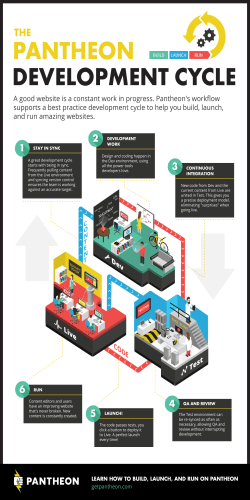
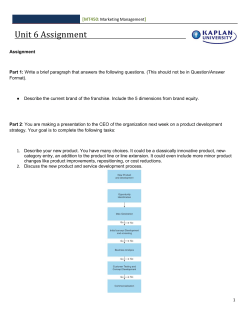
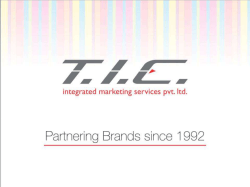


![[WCR-300S] How to Change the Wireless Network Name(SSID)](http://cdn1.abcdocz.com/store/data/000232989_1-c13ffbaf9a88e423608ef46454e68925-250x500.png)
